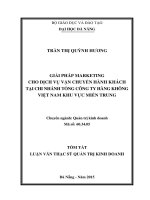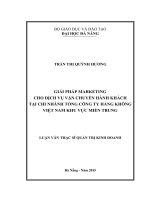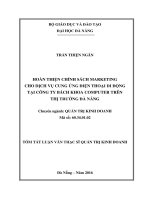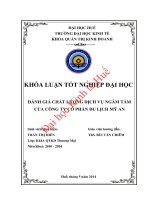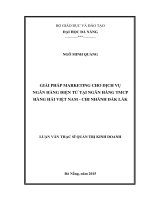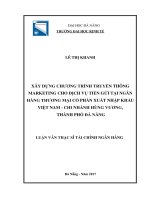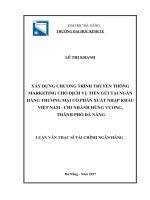An evaluation of marketing tools for overseas study consulting services in HaNoi = Đánh giá công cụ marketing cho dịch vụ tư vấn du học ở Hà Nội
Bạn đang xem bản rút gọn của tài liệu. Xem và tải ngay bản đầy đủ của tài liệu tại đây (1.19 MB, 130 trang )
iv
TABLE OF CONTENT
ACKNOWLEDGEMENTS i
ABSTRACT ii
TÓM TẮT iii
TABLE OF CONTENT iv
LIST OF FIGURES vii
LIST OF ABBREVIATIONS viii
INTRODUCTION 1
1. Rationale 1
2. Objectives of the study 2
3. Scopes of the study 2
4. Methodology of the study 3
5. Structure of the study 3
CHAPTER 1: A THEORETICAL BACKGROUND OF SERVICE
MARKETING, MARKETING IN EDUCATION, AND MARKETING IN
OVERSEAS EDUCATION SERVICE 5
A . OVERVIEW OF OVERSEAS STUDY OF VIETAM 5
B. THEORETICAL BACKGROUND 7
1.1. An overview of service marketing 7
1.1.1. Concept of service marketing 8
1.1.2. Fundamentals of service marketing 11
1.2. An overview of marketing in overseas education services 25
1.2.1. International Education services 25
1.2.2. Marketing in international education 26
1.2.3. Education agents 27
1.2.4. The role of agents 29
1.3. Marketing communication: Channels and promotion tools 31
1.4. Typical marketing tools used by OSC……………………………… …… 36
1.5. Proposed model 47
v
CHAPTER 2: EVALUATION OF MARKETING ACTIVITIES OF
OVERSEAS STUDY CONSULTANTS IN HANOI 49
2.1. Analysis of marketing activities of overseas education consultants in Hanoi
50
2.1.2. Evaluation of the frequency use of each marketing tool employed by
overseas study consultants 51
2.1.3. Evaluation of marketing tools from the perspective of overseas study
consultants 54
2.2. Evaluation of marketing tools used by overseas education consultants from
students' perspective 56
2.2.1. Evaluation of the most popular marketing tools 56
2.2.2. Evaluation of most expected/ chosen marketing tools 58
2.2.3. Comparison between the level of actual use and selection / expectation of
students of oversea study marketing tools 59
2.3. Comparison of perceptions of the effectiveness of marketing promotion
tools hold by students and overseas study consultants 61
2.4. Evaluation of marketing activities by each marketing tool 63
2.4.1. Evaluation of each marketing tool 64
2.4.2. Evaluation of OSC by tools
65
CHAPTER 3: SOLUTIONS TO IMPROVING MARKETING ACTIVITIES
OF OVERSEAS STUDY CONSULTANTS 71
3.1. General solution for Groups of marketing tools for overseas education
consultancy service 76
3.1.1. Solution for Group 1 71
3.1.2. Solutions for Group 2 72
3.1.3. Solutions for Group 4 73
3.2. Specific solutions for each marketing tool 75
3.2.1. A solution to Tool 1- Direct mail 80
vi
3.2.2. Solution for Tool 2 - Advertising 75
3.2.3. Solutions for Tool 3 – Education fairs 77
3.2.4. Solution for Tool 4 - Direct consultancy and recruitment 80
3.2.5.Solution for Tool 5 – Websites 80
3.2.6. Solution for Tool 6 - Banner advertising 82
3.2.7.Solution for Tool 7 – Listings 84
3.2.8. Solution for Tool 8 – Email marketing 84
3.2.9. Solution for Tool 9 - Seminars 85
3.2.10. Solution for Tool 10 - Pr 86
3.2.11. Solution for Tool 11 – Tele marketing 87
3.3. Expansion and renovation of other types of marketing tools 90
3.3.1. Street banner advertising 96
3.3.2. Introduction to friends, relatives, acquaintances (words of mouth advertising) 90
3.3.3. Old customer care 91
3.3.4. Overseas study links 92
3.3.6. English center 92
CONCLUSIONS 94
REFERENCES 96
APPENDIX 110
vii
LIST OF FIGURES
Figure 1 .1: Service market 13
Figure 1.2: Direct distribution channel 19
Figure 1.3: Indirect distribution channels 19
Figure 2.1: The popularity of marketing tools to OSC 50
Figure 2.2: The frequency use of each narketing tool empoyed by overseas study
consultants 51
Figure 2.3: The effeetiveness of marketing tools from the view of OSC 54
Figure 2.4: A summary of the use of marketing tools by OSC 55
Figure 2.5: The use of marketing tools by students 56
Figure 2.6: Evaluation of students‘ expectation of marketing tools for overses study 58
Figure 2.7: Comparison between the actual use and expectation of students of
marketing tools foroverseas study 59
Figure 2.8: Comparison of perceptions of the effectiveness of marketing tools
hold by students and OSC 61
Figure 2.9: Boston Matrix based model 63
Figure 2.10: Evaluation of each marketing tool 64
Figure 2.11: Evaluation of OSC by tool 1 65
Figure 2.12: Evaluation of OSC by tools 2, 6, 7, 8, 11 66
Figure 2.13: Evaluation of OSC by Tool 3 67
Figure 2.14: Evaluation of OSC by Tool 4 67
Figure 2.15: Evaluation of OSC by Tool 5 68
Figure 2.16: Evaluation of OSC by Tool 9 69
Figure 2.17: Evaluation of OSC by Tool 10 69
Figure 3.1: General solution for Groups of marketing tools for overseas education
consultancy service 74
viii
LIST OF ABBREVIATIONS
D R&C: Direct recruitment and consultants
FTU: Foreign Trade University
IIE: International Education Institution
MOET: Ministry of Education and Training
OECD: Organization for Economic Cooperation and Development
OSC: Overseas Study Consultants
PPC: Pay per click
PR: Public Relations
SEO Search Engine Optimization
VEF: Vietnam Education Foundation
VIED: Vietnam International Education Development
WOM: Word of mouth
1
INTRODUCTION
1. Rationale
Overseas education has become increasingly popular in recent years as it is viewed
as offering the student likelihood of better future employment. It is the undeniable
benefits of the abroad study and the much improved living standards of Vietnamese
people that make overseas study on the rise. In the context of international
economic integrations, overseas study has gone beyond the traditional limit in the
educational sector and become a lucrative business for overseas education
consultants (OSC).
The overseas study consulting market in Vietnam is highly competitive. Hundreds
of education consulting centers and non-profit organizations are operating in big
cities. Regrettably, the increasing number of students studying overseas has not
received a much needed concern from authorities. In Hanoi alone, not least to say in
Vietnam, there has not been official statistics of the number of students studying
overseas, education markets for Vietnamese students as well as the number and
effectiveness of OSC.
From the educational aspect, the Ministry of Education and Training (MOET) has
not taken full responsibility in managing the study of Vietnamese overseas students,
the quality of OSC and the prestige of the educational institutions which are the
destinations of Vietnamese students. From the business aspect, the Ministry of
Planning and Investment is only in charge of calculating the number of OSC.
Information of OSC can only be found in newspapers, forums or data bases of
international education institutions.
For all the reasons mentioned above, it is necessary to have a study on the
performance of OSC. Indeed, there has not been any study on this field in general
and on marketing activities of overseas education consultants in particular.
Therefore it can be said that “An evaluation of marketing tools for overseas
study consulting services in Hanoi‖ is of theoretical and practical significance.
2
2. Objectives of the study
This study will be conducted to get insight into the marketing activities of OSC in
Hanoi and examine the needs of students for overseas study service.
On the one hand, the study evaluates the promotional activities of OSC in Hanoi to
find out the answer to such questions as‖ Which marketing tools does each OSC use
and focus? ―How is each tool conducted and evaluated in relation to others?‖ etc
On the other hand, the thesis also studies the consumer behavior through surveys of
targeted students who have the need to study abroad in order to evaluate the
effectiveness of promotional activities of OSC from the students' perspective.
From the two aspects of the research, the thesis will give the answer to the question
whether these marketing and promotional activities can meet the requirements of
the consumers or not and the ultimate aim of the study is to point out solutions to
improving the marketing activities of OSC.
Hopefully, after a model to evaluate the effectiveness of OSC is made, the study
can propose solutions to improving marketing and promotional activities in
overseas education consultancy, contributing to the improvement of quality and
prestige of OSC in Vietnam‘s educational market.
3. Scopes of the study
Because of time constraint and limited ability of the author, a survey of 9 typical
OSC in Hanoi is conducted. With regard to students answering the questionnaire,
they are 100 senior students from Departments of External Economics, Business
Administration and Finance and Banking of FTU where the author is working and
200 senior students from FPT and Thang Long University.
It should be taken into account that FTU is a well established university which is
dubbed as Vietnam Harvard while Thang Long is the first private university which
has won recognition for the quality of teaching and studying and FPT is an
emerging private university which is backed up by the famous FPT group. These
3
universities, in the author's observation, have a high rate of students wishing to
study abroad.
It should also be noted that the object of the study are university students rather than
high school students. Furthermore, the concept of customers here refers to students
who want to study overseas. It is hoped that in the near future, with a larger budget
of time, a larger-scaled study which covers a wide variety of objects will be
conducted to find more comprehensive solutions to improving the effectiveness of
OSC.
4. Methodology of the study
The method of analysis, synthesis, comparison, interpretation, induction and socio
investigation are employed in the study.
Based on the theoretical background that has been mentioned in the study, 11
marketing tools will be included in the survey questionnaires for students and
marketing staff and leaders of 9 OSC. Questions will be from general to specific to
find out the popularity of marketing tools, the effectiveness of each tool in the eyes
of both OSC and students.
Survey and interview results are given in the form of figures to compare the
popularity and effectiveness of different marketing tools. The figures vary as each
focuses on each aspect of the research issues. However, promotional tools will be
deeply analyzed with a more detailed figure. Based on the results of this analysis
and on the basis of the mentioned theory, solutions to improving the effectiveness
of marketing and promotional activities of OSC will be given.
5. Structure of the study
Apart from the Introduction and Conclusion, the thesis is divided into 3 chapters as
follows:
4
CHAPTER 1: A THEORETICAL BACKGROUND OF SERVICE
MARKETING, MARKETING IN EDUCATION, AND MARKETING IN
OVERSEAS EDUCATION SERVICE
CHAPTER 2: AN EVALUATION OF MARKETING AND PROMOTION
ACTIVITIES OF OVERSEAS EDUCATION CONSULTANTS IN HANOI
CHAPTER 3: SOLUTIONS TO IMPROVING THE EFFECTIVENESS OF
MARKETING AND PROMOTION ACTIVITIES OF OVERSEAS EDUCATION
CONSULTANTS IN HANOI
5
CHAPTER 1: A THEORETICAL BACKGROUND OF SERVICE
MARKETING, MARKETING IN EDUCATION, AND MARKETING IN
OVERSEAS EDUCATION SERVICE
AN OVERVIEW OF OVERSEAS STUDY OF VIETNAM
There are an increasing number of types of scholarship available to study overseas.
Each year there are approximately 25 U.S. Government Fulbright Fellowships and
around 40-50 U.S. Government Vietnam Education Foundation (VEF) Fellowships
available for masters degree students only. Additionally there are approximately 10
Canadian government scholarships, 70 scholarships to study in the UK, 200
scholarships for study in France, 150 for study in Australia, 70 short-term and 10
long-term scholarships in Thailand. A large number of additional students receive
scholarships directly from universities, nongovernmental organizations, foundations
and other bodies. The Vietnamese Government through MOET also has a program
to approve approximately 400 scholarships for state workers to study abroad to
improve their skills. In 2009, the Vietnam International Education Development
(VIED - replaced the Management Committee of Project 322), on behalf of
Ministry of Education and Training (MOET), select and award many scholarships
for studies overseas. These scholarships comprise the following:
500 scholarships for full time doctoral study overseas,
200 scholarships for full time masters study overseas,
30 scholarships for short term training courses overseas,
100 scholarships for doctoral and master study at joint programs,
About 150 scholarships for undergraduate study overseas.
Another estimated 20,000 students are studying abroad each year on institutional
scholarships or on their own finances. These figures are further growing yearly as
the government implements its so-called 10,000 PhD program with a goal of
creating 20,000 new PhDs by 2020 through training abroad.
6
In the coming years, the market of overseas study of Vietnam will have a new and
significant trend and change. The markets receiving students studying abroad will
be extended to other regional countries such as Japan, South Korea, Taiwan,
Singapore, Malaysia, Hong Kong, and Thailand, etc due to their lower costs, and
shorter distance from home. In other words, parents will feel more comfortable
when their children can enjoy the opportunity to study in an international and
worldwide recognized environment which is not very far away from the home
country.
The modes of overseas study are also diversified. Many international schools will
invest in Vietnam to reduce costs; therefore students can enjoy overseas study
programs in their home country. Besides, the joint training programs, in-country
programs are on the rise. In these programs, students will study in Vietnam for
certain years and complete the remaining of their course either in Vietnam or in a
foreign country. In both cases students are awarded offshore qualifications.
In the case in which a foreign institution is not yet in Vietnam but located in a third
country, such as Thailand, students can also go to the third country to study instead
of going to the far away foreign institution.
The competition amongst OSC would even be tougher. It is understandable as more
foreign institutions will come to Vietnam by themselves or though the OSC when
demand for overseas education increases in Vietnam. Although when they enter into
Vietnam market, foreign institutions will need more partners in Vietnam, the
partners, i.e. the OSC still have to improve their service quality to compete with
others.
The overseas-study consulting market in Vietnam is highly competitive. Hundreds
of education consulting centers and non-profit organizations are operating in the big
cities. Moreover, the internet also gives students the ability to find the scholarships
and the school and the opportunities to go oversea to study by themselves. In
addition, the oversea-study exhibitions organized by the educational institutions
7
have provided opportunities to the student and introduced the student to ways to
assess the foreign educational institutes by themselves. This has also increased price
competition in the market.
One thing worth noticing is the commitment of Vietnam to WTO on services of
higher education, adult education which allows Vietnam to set up joint venture,
allowing the majority foreign ownership in venture capital in January / 2007; after
1/1/2009 it would allow the establishment of training institutions with 100% foreign
investment capital (other educational services such as undergraduate education has
not been committed).
After 3 years from the date of accession, the education service will not be restricted,
which means that it would be easier for students if they want to participate in an
international in country or a joint training program instead of going to study abroad.
Then the OSC have to compete with each other internally but also with international
institutions and joint training programs.
However, study abroad with its own characteristics and prominent advantages such
as a professional learning environment can certainly attract many students. In the
coming time, there will be many challenges and opportunities facing OSC; therefore
there should be solutions to improving marketing tools in order to help consultants
to better cope with challenges and seize opportunities in the present as well as in the
future.
B. THEORETICAL BACKGROUND
1.1. An overview of service marketing
1.1.1. Concept of service marketing
1.1.1.1. Concept of service
Put in the simplest terms, services are deeds, processes and performances.
Generally, services are not tangible things that can be touched, seen and felt but
rather intangible deeds and performances. To be specific, services can be whatever
8
value a business delivers to customers. Services can be deeds or performances
which happen and last for a while but services can be the entire process presented to
the customers or clients from problem analysis activities, meetings with clients and
follow-up calls.
Basing on the simple, broad definition of services, it quickly becomes apparent that
services are produced not only by service businesses but also in relation to the
offerings and participation of many manufactured-goods producers. For instance,
machine manufacturers offer warranties and maintenance services for their
products, food producers provide delivery, inventory management, staff-training
services. These above mentioned are all examples of services as deeds, processes
and performances.
In short, it can be learnt from the definition that service needs to be connected with
the activity from which service is generated, say, travel service, legal service etc.,.
In all of the cases, each type of service brings some values to the consumers. The
value of service is accompanied with the benefit that customers get from that
service. However, there are also some arguments that products customers purchase
and use at the production place and cannot be taken away are known as service.
1.1.1.2. Concept of marketing
Marketing has been viewed traditionally as a business activity. Business
organizations exist to satisfy human needs, especially material needs. Consequently,
one way to define marketing is from the business perspective. For instance,
marketing has defined as the "delivery of higher standards of living".
Other definitions refer to marketing as an exchange process. This process involves
at least two parties: buyer and seller. Each party gives up something of value and
receives something of value. Noted marketing scholar Philip Kotler defines
marketing as "a society process by which individuals and groups obtain what they
need and want through creating, offering, and freely exchanging products and
services of value with others." [72]
9
Because marketing activities bring about exchanges, marketing is an essential
function in an economic system. In a free-enterprise economy, resources are
allocated by interaction of supply and demand in the marketplace. Marketing
activities and institutions' provide the framework and mechanisms for this
interaction and exchange taking place.
Although the business aspects of marketing are important, business-oriented
definitions of marketing have been challenged. Critics observe that marketing
involves a wide range of activities and organizations and should be viewed from a
broader perspective. These critics point out that marketing takes place in not-for-
profit organizations, such as hospitals, universities, and social and government
agencies. New applications of marketing are further evidence of its growing
importance in our society. Any definition must recognize that marketing is a
fundamental human activity and that marketing decisions affect everyone's warfare.
The American Marketing Association (AMA) provides a definition of marketing in
its broader context: "Marketing is the process of planning and executing the
conception, pricing, promotion, and distribution of ideas, goods, and services to
create exchanges that satisfy individual and organization goals"
By including exchange as part of the definition, the AMA has expanded the
marketing process to include all types of organizations. This broadened or generic
view of marketing recognizes the importance and application of marketing to not-
for-profit organizations and situations. As in for non-profit businesses, a careful
planned and coordinated marketing program can help a not-for profit organizations
reach its goals, whether they are to attract more members, to increase donations, or
to provide better client services.
Importance of Marketing
According to Blythe, (2005) marketing is the management process which identifies,
anticipates, and supplies customer requirements efficiently and profitably [15].
Modern businesses compete in complex global marketplaces. Competition has
10
never been so fierce. Well organized high quality, low cost competitors are
emerging daily. We can no longer rely upon our belief that traditional product
services and technological superiorities are sufficient to retain and grow our
businesses in the environment. In a competitive market environment, building and
maintaining a market requires investment in marketing and promotion. [60]
If marketing is the engine that drives the organization, then marketing research is
the process that keeps the engine tuned. [54]
1.1.1.3. Concept of service marketing
Marketing activities, even marketing the service sector developed rapidly in recent
years. Services marketing are regulated by the characteristics of the production,
distribution and use of service. The scope of Service Marketing includes the whole
process from pre-consumption, in production, distribution and after-sale- service.
Marketing is one of management tools of a manager which has so far proved its
effectiveness and got tremendous results. Marketing has been applied not only in
doing business but also in many other fields of social life, namely environment
marketing, social marketing, politics marketing, public non-profit products
marketing so on and so forth. The concept of marketing, therefore, has a boarder
insight than it used to be. And services marketing are one of the extensions of the
new and broad definition of the traditional concept of marketing.
Generally, service marketing is known as a form of marketing which focuses on
selling services and a form of marketing based on relationship and value. Services
as defined previously can be tricky to sell and marketing a service-base business is,
therefore, different from marketing a product-base business in some senses
including: the buyer purchases an intangible product; the service may be based on
the reputation of a single person; it is more difficult to compare the quality of
similar services and the buyer cannot return the service. Thus is why once markets a
service business, the owner should bear in mind that reputation, value, delivery of
service and follow-through are keys to a successful venture.
11
1.1.2. Fundamentals of service marketing
1.1.2.1. Characteristics of service: The services have unique characteristics which
make them different from that of goods. The most common characteristics of
services are:
Intangibility.
Inseparability.
Perish ability.
Variability
Intangibility
Services are activities performed by the provider, unlike physical products they
cannot be seen, tasted, felt, heard or smelt before they are consumed. Since, services
are not tangible; they do not have features that appeal to the customers' senses.
Their evaluation, unlike goods, is not possible before actual purchase and
consumption. The marketer of service cannot rely on product-based clues that the
buyer generally employs in alternative evaluation prior to purchase. So, as a result
of this, the services are not known to the customer before they take them. The
service provider has to follow certain things to improve the confidence of the client:
The provider can try to increase the tangibility of services. For example, by
displaying a plastic or a clay model showing patients an expected state after a
plastic surgery. The provider can emphasize on the benefits of the service rather
than just describing the features.
Not all the service product has similar intangibility. Some services are highly
intangible, while the others are low i.e. the goods (or the tangible component) in the
service product may vary from low to high.
For example: Teaching, Consulting, Legal advices are services which have almost
nil tangible components; While restaurants, fast food centers, hotels and hospitals
offer services in which their services are combined with product (tangible objective)
, such as food in restaurants, or medicines in hospitals etc.
12
Inseparability
Services are typically produced and consumed simultaneously. In case of physical
goods, they are manufactured into products, distributed through multiple resellers,
and consumed later. But, in case of services, it cannot be separated from the service
provider. Thus, the service provider would become a part of a service.
For example: Taxi operator drives taxi, and the passenger uses it. The presence of
taxi driver is essential to provide the service. The services cannot be produced now
for consumption at a later stage / time. This produces a new dimension to service
marketing. The physical presence of customer is essential in services. For example:
to use the services of an airline, hotel, doctor, etc a customer must be physically
present.
Inseparability of production and consumption increases the importance of the
quality in services. Therefore, service marketers not only need to develop task-
related, technical competence of service personnel , but also , require a great input
of skilled personnel to improve their marketing and inter personal skills.
Perishability
Services are deeds, performance or act whose consumption take place
simultaneously; they tend to perish in the absence of consumption. Hence, services
cannot be stored. The services go waste if they are not consumed simultaneously i.e.
value of service exists at the point when it is required.
The perishable character of services adds to the service marketers' problems. The
inability of service sector to regulate supply with the changes in demand; poses
many quality management problems. Hence, service quality level deteriorates
during peak hours in restaurants, banks, transportation etc. This is a challenge for a
service marketer. Therefore, a marketer should effectively utilize the capacity
without deteriorating the quality to meet the demand.
13
Variability
Services are highly variable, as they depend on the service provider, and where and
when they are provided. Service marketers face a problem in standardizing their
service, as it varies with experienced hand, customer, time and firm. Service buyers
are aware of this variability. So, the service firms should make an effort to deliver
high and consistent quality in their service; and this is attained by selecting good
and qualified personnel for rendering the service.
1.1.2.2. Market in service marketing
The concept of market in Marketing is different from that of tangible products. It is
known as the potential customers who have demands for specific products provided
by enterprises. The concept of market in service marketing is divided into 6 basic
types which can be illustrated as follows:
Figure 1 .1: Service market
'
(Source: Nghiem, Luu Van (2001; 80) - A textbook of Service Marketing of
Vietnam National Economics University- Statistics Publishing House.) [99]
Customer market
Internal
market
Interactive
Market
Supplying
market
Employment
market
Power
market
14
Customer market: For any enterprise to be successful, it is a must to focus on the
customer market which is the buyers‘ demand for a specific type of product or
service. The lowest influence of marketing on this market is to build customer
loyalty and attract the new and potential ones. It is quite difficult to understand the
customers of a service. The job of marketers, therefore, is to do research on
customer behaviors to find out what has great influence on their buying decisions.
One of the big concerns of service marketing lies in customer maintenance and
repeated business.
Interactive market: Interactive market occurs in the moment when the customers
interact with the organization and the service is produced and consumed. It is also
the interaction between different organizations taking part in the process of
providing service. These components of the whole process interlink and depend
much on each other to provide the end-service to customers.
Supplier market: The supplier market has changed a lot and played an important
part in both service and tangible products. Marketing activities in this market,
therefore, is to provide all the resources, which means that marketer needs to
establish some essential middle men, develop the relationships with the future and
present resources together with developing marketing campaign to distribute these
resources to supplier market. Meanwhile organizations also need to have a plan to
promote their market resources.
Employment market: How to provide adequate qualified and skillful workforce for
interactive market is a question of concern for the reason that there has always been
a shortage of qualified and skillful workers for not only service providers but also
any organizations doing business in the market. The supply and demand in
employment market seems to be complicated. There has been a great demand for
the high quality workforce working in several industries but the supply capacity still
remains low due to a number of reasons.
15
Power market: This market is suitable to relationship based Marketing. Enterprises
used Marketing resources and strategies to establish relationship with powerful
groups and corporations, including:
Financial and Baking Corporations: They make decisions on capital, payment
ability, amount of cash, etc
Powerful Corporations: Enterprises should establish the relationship to enter the
market and find out opportunities in future.
Authorities: Enterprises should understand and follow regulations and rules
related to trade and commercial activities.
Economic Associates: Enterprises should create a friendly relationship and
support their positive activities.
Internal market: An internal market operates inside an organization or a set of
organizations including employees, providers and internal customers. The internal
customers also have needs and demands that requires organizations to meet. Thus,
organizations should do research to find out the internal customers‘ needs and wants
as well as identify internal customer segmentation and work out the factors that
influence internal customers‘ needs which often associates with themes like their
personal lives, their families, working conditions, labor-saving devices, incomes,
promotion, vacation, benefits and rewards, etc.
The organizations should apply marketing tools to attract external customers to
increase internal customers ‗loyalty. Marketing researches, communication and PR
campaigns should focus directly on the employees and indirect labors as well as
external customers to attract the skilled labor force to produce high quality services.
Services marketing mix is different from that of product. Product marketing mix,
also known as the 4 P's of Marketing, is the combination of product, price, place
(distribution), and promotion.
In service marketing, the traditional 4Ps mar-mix is extended to 7Ps mar-mix to be
compatible with the successful proposition for the services industry. The 7Ps of the
16
marketing mix can be discussed as: product service; price; place; promotion;
people; processes and physical evidence.
Basing on the specification of the service and market segment, marketers can
coordinate the 7Ps to develop a marketing strategy which is suitable for their
marketing purposes and get results.
1.1.2.3. Mar-Mix in Marketing Service
1.1.2.3.1. Product policy
A product in general is a broad concept of things or set of activities that bring
values to customers. Customers don‘t actually purchase goods or services but they
purchase the benefits and values that goods and services offer them.
Service is a set of activities including intangible factors which create the value chain
and bring the overall benefit. Thus, service is often classified into the core service
and relating service.
Core service is the main service which identifies the main business activities of
any enterprise. In this sense, the core service can meet a certain need of the
customers for it brings a certain values to customers which can help them to
distinguish this service from the others.
Relating service is the secondary services depriving from the core one which add
values to customers and help them to have better feeling and understanding of the
core service. The more relating services are offered, the more benefits and values
the customers can get and that help the customers identify the difference in service
offering between one enterprise and its main competitors.
In order to successfully survive and stay ahead in a harshly competing market,
enterprises need to make a numbers of decision related to their core-service.
The decision of the main service introduced to the market is made on the basis of
identifying the general needs of the service in the market and also on the specific
service orientation. The main (core) service needs to be associated with the target
market.
17
The decision of primary service is made in accordance with service structures,
different service levels and service-providers.
The overall service is a set of the main (core) service, relating services and
primary services. When deciding the overall service to be offered, the providers
should consider the overall benefits that the services can deliver as well as compare
these benefits with those of the main competitors.
The service diversification decision is made to meet diverse requirements of
customers. That is when enterprises introduce different basic services to meet
different market segments at the same time.
1.1.1.3.2. Pricing policy
Price plays an important role in services marketing mix and has a large impact on
profit and also decides the value of the primary service that is offered to customers.
Price is considered a decisive factor in building enterprise‘s image and positioning
the service being offered.
How a company positions itself in the competitive market depends much on its
pricing policy. Pricing, therefore, is of great consideration. Price a premium item
too low, for example, and customers will not believe the quality is good enough.
Conversely, put too high a selling price on value lines and customers will purchase
competitors‘ lower-price items. With this purpose in mind, companies can set a
reasonable price compatible with the quality and characteristics of the service for
the reason that price has much influence on the intangible and non-material value of
service.
In marketing mix, pricing tool is of great significance and effectively affects other
tools and factors which helps bring value and benefit for the company. Price is
something that is sensitive and draws much people attention. Pricing the service,
therefore, needs take several factors into consideration.
First and foremost, pricing should stem from the true value that the service can
deliver to customers. The service pricing strategy is often identified on such basis as
18
the service production cost, competition in the market and the value that customers
can get from the service.
From the service providers‘ perspective, pricing policy should meet gross margin
requirement and ensure profit for the company to survive and maintain sustainable
development.
1.1.1.3.3. Place Policy
Distribution channels in service industry are a broader concept in comparison with
the traditionally known ones. Distribution channels are comprised from such factors
as service products, negotiation, information, ownership and promotion.
Service is a special goods in which the production, distribution and consumption of
service is a continuous and inseparate process. In this sense, the service consumers
also participate in both service supply and consumption process.
Distribution channels in service is normally short and direct channels which in
reality is known as the bridge between consumers and service or bring services to
consumers in different market sectors. Distribution channels may consist of service
providers, a number of intermediaries (sales representatives, agents, wholesalers,
retailer, etc), and consumers.
There are three main factors in distribution channels:
Members of distribution channels and the relationship among these members.
Different functions performed by members of the channels together with
equipments, facilities and technologies used in distribution channels.
The whole service produced by distribution channels‘ members.
These three main factors in distribution channels all participate in the buying and
selling process with other members in that channel. Each member has his own
capacity and target customers which make a unique channel representing a mix of
power, contradiction and cooperation.
Particularly, distribution channels in service are known as follows:
19
Direct channel: is the most effective distribution channel for service and very
common for small businesses. Services can be sold directly to the consumer on-site
i.e. directly from your shop, office or home by consumers physically coming into
the premises to make a purchase.
Direct channel is appropriate to pure service because of the high intangibility of
service and high demand of the relationship between service providers and
consumers. Direct channel can work effectively in such services as: healthcare,
education and training, art and entertainment.
Indirect channel includes the participation of a number of intermediaries as
illustrated below.
Figure 1.2: Direct distribution channel
(Source: Nghiem, Luu Van (2001; 281)- A textbook of Service Marketing of
Vietnam National Economics University- Statistics Publishing House.) [99]
Figure 1.3: Indirect distribution channels
(Source: Nghiem, Luu Van (2001; 281)- A textbook of Service Marketing of
Vietnam National Economics University- Statistics Publishing House.) [99]
Consumer
Service provider
At-home service
Service
Consumer
Intermediaries
Service
provider
Buying
Agents
Selling
Agents
20
In reality, indirect channels work more effectively for some particular service. For
example, service industries such as aviation, tourism, hotel chains, banking etc., can
make full use of agents, rep offices in different market segments and market areas.
Decisions in service distribution
In order for enterprise to have an effective distribution channel, enterprise needs to
base on the features of the service that it is offering together with the true demand
of the market. Accordingly, enterprise should consider making the right decision to
get the best result.
1.1.1.3.4. Promotion Policy
Communication in service plays an important role in Mar-mix, which provides
information to customers and solutions to the internal relationship inside the
company as well as the relationship between company and the public.
Communication makes things clear and help company position itself in the market
so that the customers can have more awareness of the value of service.
Communication in service includes such things as advertisement (1), personal
communication (2), promotion (3), which will be discussed as follows:
(1) Advertisement is one common form of communication used by almost all
organizations. Advertisement in service is to identify information of the service,
position service, develop service concept, have better insight into the service quality
and quantity, create customer‘s expectation and persuade customer‘s spending.
Advertisement methods, advertisement scripts, advertisement objectives and
budgets are also matters of concern in advertisement policy plan.
Advertisement methods consist of mass media such as television, radio, press,
cinema and other means which can help convey information to public, for example
posters, directories, word of mouth and mail shots. Companies should base on their
advertising objectives to choose the appropriate methods and language of
advertisement.

